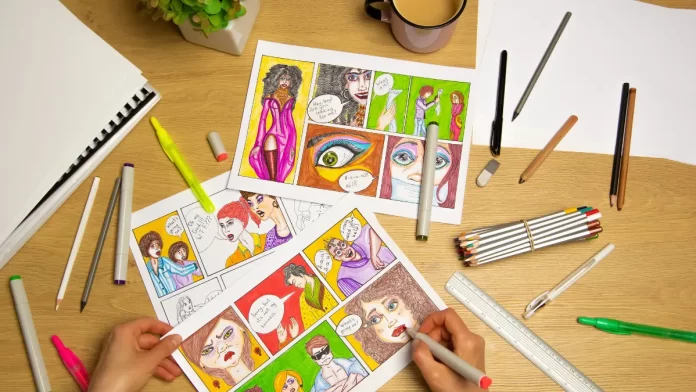In comics, words are supportive, and the art takes center stage. But what does it take to make a comic?
Comics are printed on paper, and a lot of it. This article will discuss how a comic book goes from sketch to full color on a newspaper press.
The Artwork
When it comes to comic book printing, quality starts with the artwork. A comic book artist creates a story and sketches the pages in pencil. These rough drafts help the author ensure that the characterization, dialogue, and storyline are impactful and well-executed. It also helps them experiment with the placement of text and speech bubbles.
Once the story is finalized, the pencil work is sent to an inker. The inker darkens the pencil lines and adds details such as shadowing and highlights to bring the characters to life. Inkers may also alter the script, ensuring the art aligns with the story. After the inker is satisfied with the work, it is passed to the colorist.
Before computers, most comics were printed in spot color using a newspaper press. This process was time-consuming and required a lot of skill, as the artists had to manually apply the colored layers on top of the black lines. Today, comics are often colored digitally, which allows for quicker turnarounds and more accurate coloring.
When it comes to comic book printing, the right printer can make all the difference. Look for a company with experience and a record of producing high-quality work. Ask for samples and references, and choose a print shop that offers proof before printing the entire run. It will allow you to ensure that everything is perfect before the final product is pressed.
The Pages
Comic books combine words and images to transport readers to new worlds, captivate them for generations, and introduce unforgettable characters. They’re a complicated form of art that requires many steps before they reach the printed page, from writing and illustrating to layout and design.
A comic book starts with a script, which a writer often drafts to ensure the characterization, dialogue, and story are impactful, well-executed, and straightforward. Next, an illustrator makes sketches to create the black-and-white outlines of the panels that make up the story. If the artist isn’t also the writer, they will work with a writer to bring their concept to life.
Once the art is complete, it’s scanned into a computer and given color by a digital colorist. Using a code that identifies the four colors that make up the base for each color, the colorist brings the artist’s vision to life. Once the master pages are digitally colored, a proof copy is printed for final approval before the comic is mass-printed.
Specialized comic printers offer various paper options that enhance the reading experience and help the art stand out. They can also print smaller batches of books based on actual demand, eliminating publishers’ need to overprint or take financial risks with unsold copies.
The Inks
Whether a writer-only type or a more traditional illustrator, comic book creators usually need to work with a writer to assemble the text and dialogue. After that, the artist roughs out a pencil sketch of each page and then begins drawing it in ink with various pens. It is the stage where the lines begin to come to life, and the inker’s skills are honed.
The inker may work alone or as part of a team. For example, inker/penciler teams enjoyed wide recognition for their work. The distinction between penciller and inker is less structured nowadays, and it’s not uncommon for an artist to take on both roles.
In the past, comic books were colored by hand using a simple system of four color inks that were easy to reproduce on the cheap newsprint paper used for most comics. Today, most comics are colored digitally from a master scan of the original art. The digital coloring process involves using a code that relates the four base colors to produce the desired effect.
In addition to the four-color printing process, many modern comics are produced on high-quality, uncoated, or glossy paper. That makes them more durable and gives them a more luxurious feel than their traditional counterparts. The paper’s thickness is also necessary, affecting how the comic holds up over time and how easily it can be read.
The Covers
Comic book printing requires a team of dozens of people to bring the story from conception to your local shop or digital tablet. A writer creates the story; a penciller draws it by hand or with digital art programs; an inker refines and outlines the drawings; a colorist brings the drawings to life using a palette of four base colors; and a letterer adds text. A designer formats the work for printing, and a publicist helps ensure readers know about it.
In the past, comic strips were printed using stone lithography, wherein a drawing was photographed on a metal printing plate and then etched with acid to create raised areas. This method required a large press but could produce detailed and rich illustrations. As comics grew more sophisticated, the process was replaced with spot printing—using a single color at a time—and later with Ben-day dots, which use small and closely spaced cyan, magenta, yellow, and black ink to create secondary colors and shades of each primary color.
When selecting a printer for your comic book, choose one with a history of producing high-quality comic books. Print on glossy paper, making the vibrant colors and bold lines stand out, or matte paper for a more subdued look. Choose saddle stitch or glue binding to hold your comic together, depending on your page count.



